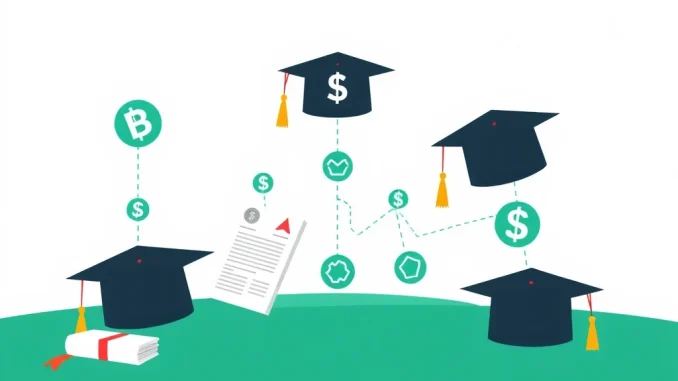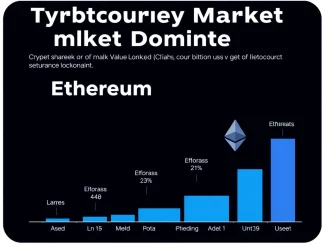
Imagine a world where the massive, multi-trillion dollar student loan market isn’t just about traditional banks and endless paperwork, but is integrated with blockchain technology. This isn’t just a futuristic concept; leaders in the Web3 space see it as a significant catalyst for widespread crypto adoption.
Animoca Brands Vision: Tapping into Student Loans
Speaking recently at Consensus 2025 in Toronto, Animoca Brands co-founder Yat Siu shared a compelling perspective. He identified the global student loans sector, currently valued at a staggering $3 trillion, as a prime target for expansion within the crypto ecosystem. Siu believes that by integrating Web3 financial tools into the education industry, we could see a rapid acceleration in how people, especially younger demographics and those currently underserved by traditional finance, begin using cryptocurrencies and decentralized platforms.
Why Student Loans? A Catalyst for Crypto Adoption
Why focus on student loans? The reasoning is multi-faceted:
- Market Size: A $3 trillion market offers immense potential for bringing new capital and users into the crypto space.
- Demographics: Students and recent graduates are often more open to new technologies and digital solutions than older generations. Engaging them early could create lifelong users of crypto and Web3 services.
- Financial Pain Points: Traditional student loan systems can be complex, inefficient, and opaque. Web3 offers potential solutions for greater transparency and efficiency.
- Inclusion: For unbanked or underbanked individuals pursuing education, Web3 finance could provide alternative pathways to access funding and manage debt.
Tapping into this market isn’t just about finance; it’s about onboarding a generation into the digital asset world through a familiar, albeit often burdensome, part of their lives.
How Web3 Finance Could Transform Student Lending
Yat Siu’s idea centers on moving student loans onto the blockchain, leveraging Web3 finance tools. What does this mean in practice?
It could involve:
- Tokenization of Loans: Representing loan agreements or future income streams as digital tokens.
- Smart Contracts: Automating loan disbursements, repayments, and interest calculations based on predefined conditions, increasing efficiency and reducing administrative costs.
- Decentralized Identity (DID): Using self-sovereign identity solutions to verify student and lender credentials securely and privately.
- Decentralized Lending Protocols: Creating peer-to-peer or pooled lending models where capital providers on the blockchain fund student loans.
Moving these complex financial instruments on-chain could streamline processes, reduce intermediaries, and potentially lower costs for borrowers over time.
Boosting DeFi: The Impact on Total Value Locked
One of the most significant potential outcomes highlighted by Siu is the impact on the DeFi ecosystem. He suggested that integrating student loans on-chain could boost the Total Value Locked (TVL) in decentralized finance by over four times its current levels. TVL represents the total value of crypto assets locked within DeFi protocols. A substantial increase like this would signal significant growth and maturity for the DeFi space, bringing a new class of real-world assets (RWAs) onto the blockchain.
Think about it: billions of dollars currently tied up in traditional loan systems could potentially flow into DeFi protocols, providing liquidity and creating new financial opportunities within the decentralized ecosystem. This could attract more institutional interest and further validate the potential of DeFi beyond speculative trading.
Benefits Beyond TVL: Who Gains from Web3 Student Loans?
While the boost to DeFi TVL is noteworthy for the crypto market, the benefits extend to users:
- Increased Accessibility: Potentially opening up access to educational funding for individuals in regions with underdeveloped traditional banking systems.
- Greater Transparency: Blockchain’s immutable ledger can provide clear, verifiable records of loan terms, payments, and balances, reducing disputes.
- Potential for Lower Costs: Reducing intermediary fees and administrative overhead through automation via smart contracts.
- Financial Literacy: Engaging with Web3 finance tools for something as crucial as education funding could significantly boost financial literacy and comfort with digital assets among young people.
For Animoca Brands, a company deeply involved in Web3, gaming, and digital property rights, this vision aligns with their goal of building out the open metaverse and digital economies. Bringing real-world financial processes like loans into the Web3 space is a logical step in creating a more comprehensive digital financial infrastructure.
Navigating the Challenges: Is Web3 Student Finance Realistic?
While the potential of Web3 finance in the student loan market is exciting, significant hurdles remain. It’s not a simple flip of a switch.
Key challenges include:
- Regulation: Student loans are heavily regulated worldwide. Integrating them into a decentralized, global system requires navigating complex legal and compliance frameworks.
- Data Privacy: Handling sensitive personal and financial data on a public or permissioned blockchain requires robust privacy solutions.
- User Education: The complexity of Web3 can be daunting. Educating students and lenders on how to use these new systems is crucial for adoption.
- Technical Infrastructure: Building and scaling secure, reliable blockchain infrastructure capable of handling the volume and complexity of a global loan market is a massive undertaking.
- Credit Assessment: Developing decentralized or hybrid systems for assessing creditworthiness is essential for managing risk in loan portfolios.
Addressing these challenges requires collaboration between Web3 developers, financial institutions, educational bodies, and regulators.
The Road Ahead for Crypto Adoption in Education
Yat Siu’s comments highlight a growing recognition that for crypto adoption to move beyond speculation and niche use cases, it must integrate with fundamental real-world financial needs. The student loan market, with its scale and demographic reach, presents a compelling opportunity.
While a fully on-chain global student loan system may be years away, exploring pilot programs, specific Web3 tools for loan management, or alternative financing models using blockchain could pave the way. The conversation started by leaders like Siu is crucial for pushing the industry to think about how Web3 can solve real problems for everyday people.
Conclusion
The idea of leveraging the $3 trillion student loan market as a driver for crypto adoption is ambitious but potentially transformative. As proposed by Animoca Brands co-founder Yat Siu, integrating Web3 finance tools could not only significantly boost DeFi TVL but also bring efficiency, transparency, and financial inclusion to millions. While challenges are substantial, the potential rewards – accelerating adoption, creating lifelong users, and building a more robust decentralized financial system – make this a concept worth exploring and developing. The journey to integrating blockchain into traditional finance is complex, but the student loan market might just be a key battleground for the future of mass crypto adoption.



